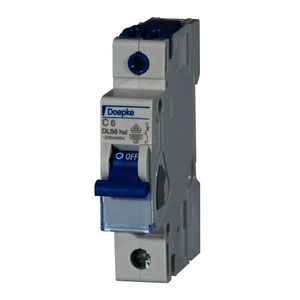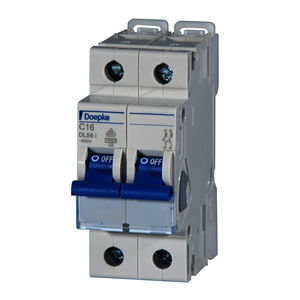
- Electricity - Electronics
- Switch and Relay
- Thermal-magnetic circuit breaker
- Doepke Schaltgeräte GmbH
- Products
- Catalogs
- News & Trends
- Exhibitions
Thermal-magnetic circuit breaker 20 A | ELS 3 B20/1+Nshort-circuitmodularminiature

Add to favorites
Compare this product
Characteristics
- Type
- thermal-magnetic
- Electrical characteristics
- short-circuit
- Operating mode
- modular
- Other characteristics
- miniature
- Primary current
20 A
- VAC
Max.: 230 V
Min.: 12 V
- VDC
Max.: 60 V
Min.: 12 V
Description
An important stipulation of DIN VDE 0100 is to protect cables, lines and installation devices from overload and short-circuits. This requirement can be met using miniature circuit-breakers (MCBs). In industrial installations and also in commercial buildings, they often take on additional protection of equipment and devices where there are usually higher requirements than when used in residential buildings. Miniature circuit-breakers utilise both the magnetic and heat effect of the electrical current. If the current jumps to a value that is too high when a short-circuit occurs, the MCB interrupts the circuit using the magnetic field of an energised coil. The heat that develops when there is continuous overload causes the bimetal to warp, which trips the breaker. Miniature circuit-breakers from series ELS have a compact design. They have a contact position indicator, protection against wires being lodged behind terminals and can be used for rated short-circuit currents up to 6 kA. They are only permitted for export. Miniature circuit-breakers with characteristic B ensure standard protection for lighting and socket circuits. As their short-circuit trip is three to five times the rated current, they should not be used to fuse-protect load circuits with high switch-on currents. They replace the former L or H characteristic.
Catalogs
No catalogs are available for this product.
See all of Doepke Schaltgeräte GmbH‘s catalogsOther Doepke Schaltgeräte GmbH products
Miniature circuit-breakers
Related Searches
- Single-pole switch
- Technology switch
- Switching relay
- Circuit breaker
- Isolator switch
- Electromechanical switch
- Contactor
- Time relay
- Electromechanical relay
- Toggle switch
- Multipole disconnect switch
- 3-pole disconnect switch
- Current circuit breaker
- Distribution circuit breaker
- DIN rail mounted time relay
- Power contactor
- Electromagnetic contactor
- Control electric switch
- AC circuit breaker
- MCB circuit breaker
*Prices are pre-tax. They exclude delivery charges and customs duties and do not include additional charges for installation or activation options. Prices are indicative only and may vary by country, with changes to the cost of raw materials and exchange rates.





